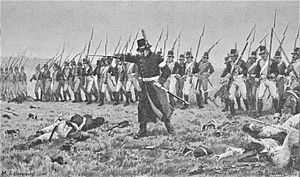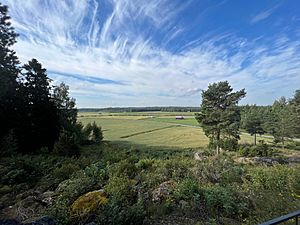Battle of Oravais facts for kids
Quick facts for kids Battle of Oravais |
|||||||
|---|---|---|---|---|---|---|---|
| Part of the Finnish War | |||||||
 "The final Swedish charge" by Magnus Adlercreutz |
|||||||
|
|||||||
| Belligerents | |||||||
| Commanders and leaders | |||||||
| Strength | |||||||
| Swedish sources: 5,000–5,500 Russian sources: 7,000 |
Russian sources: 6,000 in all Less than 5,000 engaged |
||||||
| Casualties and losses | |||||||
| Swedish sources: 103 killed 276 wounded 361 missing Russian sources: 1,000–1,500 |
Russian sources: 121 killed 665 wounded 109 missing Other Russian sources: 1,000–1,100 |
||||||
The Battle of Oravais was a very important fight in the Finnish War. This war happened between Sweden and the Russian Empire from 1808 to 1809. It was part of the bigger Napoleonic Wars across Europe.
The battle took place in what is now Vörå, a town in western Finland. Many people see it as a turning point in the Finnish War. It was Sweden's last real chance to win the war. Oravais was one of the bloodiest battles of the conflict. Historians think this was because the Swedish army was tired and losing hope. Their defeat here led to Sweden losing Finland to Russia.
Contents
Why the Battle of Oravais Happened
Retreating Armies and New Plans
At the start of the Finnish War, Swedish forces had to pull back to Oulu. But then, they managed to push the Russians back. They even reached an area called Savonia. This happened even though a big fortress, Sveaborg, had surrendered by the end of summer 1808.
However, Russia quickly got its strength back. By late August, the Swedish army was again moving north. They were going along the coast road, trying to get away from the Russians.
Avoiding Being Trapped
To avoid being surrounded, a Swedish officer named Georg Carl von Döbeln was sent ahead. He went to Nykarleby with his soldiers. The Swedish army was starting to panic. On September 13, the army moved to Oravais. They stopped there to wait for news from von Döbeln. He was fighting the Russians at Jutas.
They heard the sound of cannons from Oravais. So, more Swedish soldiers were sent to help von Döbeln. Meanwhile, the main Russian army was chasing the Swedes very quickly from Vasa.
Russian Forces Arrive
The night before September 14, the Russian soldiers camped along the road. This was between Vörå and Oravais. General-Major Yakov Kulnev's troops were in the lead. They were the first to find the Swedish soldiers.
The Battle of Oravais Begins
Early Morning Skirmishes
When the sun came up, the first shots were fired. This happened between Kulnev's Russian troops and a Swedish outpost near a bridge in the forest. The fighting quickly grew more intense. The Swedish position got more soldiers, and the rest of the Russian army arrived.
The battle continued with many soldiers lost on both sides. Around 10 a.m., the Swedes could not hold their ground. They had to fall back to their main defensive positions. A 15-year-old officer, Wilhelm von Schwerin, bravely covered their retreat with one artillery cannon.
Swedish Defenses and Russian Attacks
The main Swedish army was set up along a high ridge. To their right, an inlet from the Baltic Sea protected them. The Fjärdså stream also helped protect their position. The forest in front of the ridge had been cleared. This gave the Swedish cannons a clear view of the arriving Russians. The Russians were gathering at the edge of the forest.
Then, both sides started firing their cannons at each other. This lasted for about an hour. After that, the Russians launched a direct attack on the Swedish lines. Kulnev's troops attacked the Swedish right side. But they got stuck in the Fjärdså stream and were pushed back.
Counterattacks and Reinforcements
The Russians then sent more soldiers to their right side. They attacked again, but the Swedes pushed them back. Strangely, the Swedes then left their positions and attacked the Russians. The Swedish commander, Carl Johan Adlercreutz, had not given this order. The Swedish counterattack faced very heavy fire. They had to retreat with many losses.
By 2 p.m., the battle was still not decided. The Russians tried a second time to get around the Swedish left side. This made the middle of the Russian line weaker. Adlercreutz saw this and ordered a strong attack. Despite heavy Russian fire, the Swedish attack moved quickly. The whole Swedish line pushed forward. The entire Russian line was forced to go back into the forest where the battle had started.
However, the Swedes were running out of ammunition. This stopped Adlercreutz from winning completely. As more Russian soldiers arrived, the tired Swedish army went back to their defensive spots. The battle was still undecided. But then, General Nikolay Mikhailovich Kamensky ordered another attack on the weak Swedish left side.
When this attack began, night had fallen. The battle had been going on for fourteen hours. It was too much for the Swedish army. They quickly retreated north.
What Happened After the Battle
A Difficult Retreat
A Swedish officer, Carl Johan Ljunggren, described the retreat from Oravais. He said it was so dark you could not see who was next to you. Hundreds of sounds filled the night. Wounded soldiers cried out in different languages. Cannon operators yelled at their tired horses. They cursed every time they got stuck. Wheels and weapons rattled. Soldiers shouted. Everyone was exhausted and hungry.
Finally, the army reached Nykarleby. The Russians did not follow them. Their forces were also completely worn out.
The Outcome of the Battle
The Battle of Oravais showed that the Swedish army was just as good at fighting as the Russian army. However, Sweden's overall situation in the war was hopeless. They were only allied with Great Britain. They faced the powerful forces of Napoleon's Europe and his Russian ally. Oravais was just one battle on the way to Sweden's final defeat.
Swedish reports said they lost 103 soldiers killed, 276 wounded, and 361 missing. Russian sources claimed the Swedes lost between 1,000 and 1,500 men. The Russians reported 121 killed, 665 wounded, and 109 missing. Other Russian reports said their total losses were between 1,000 and 1,100 men.
Images for kids





